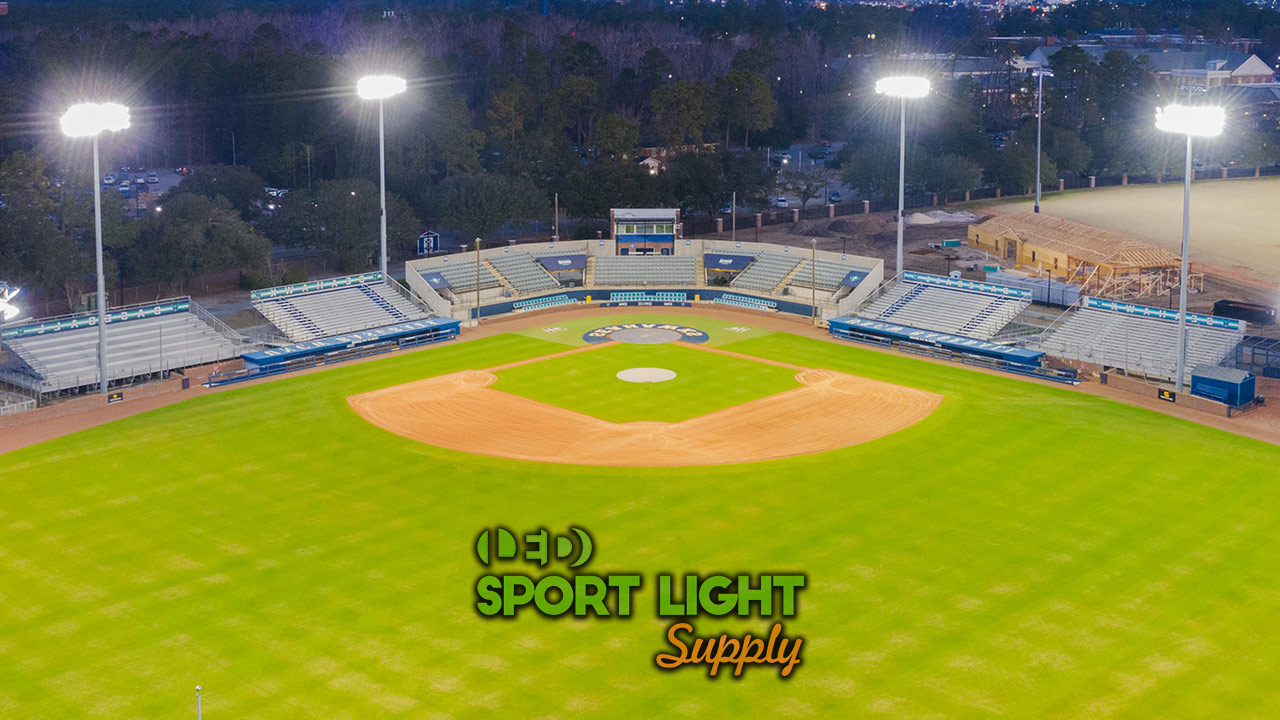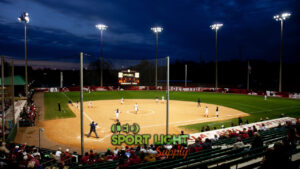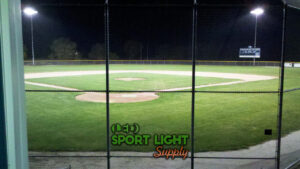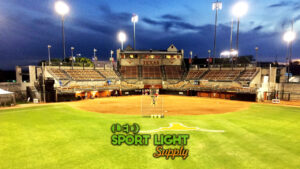No matter your budget is tight or not, you may want to know the cost of baseball stadium lights, so you can make a better plan. In fact, the softball field light price depends the size of infield/outfield, lighting requirement, light pole layout and other factors. This article introduces to you the factors that determine the cost, the average baseball field lighting cost as well as how to buy the cheap lamps.
If you need the quick answer, that’s – the baseball field LED lighting cost ranges from $12,480 to $117,000. The running cost of baseball or softball field flood lights ranges from $6 to $60 per 10,000W per hour. Therefore, choosing the right type of lighting can save electricity cost in the long run.
Softball Stadium and Baseball Field Light Cost Calculation
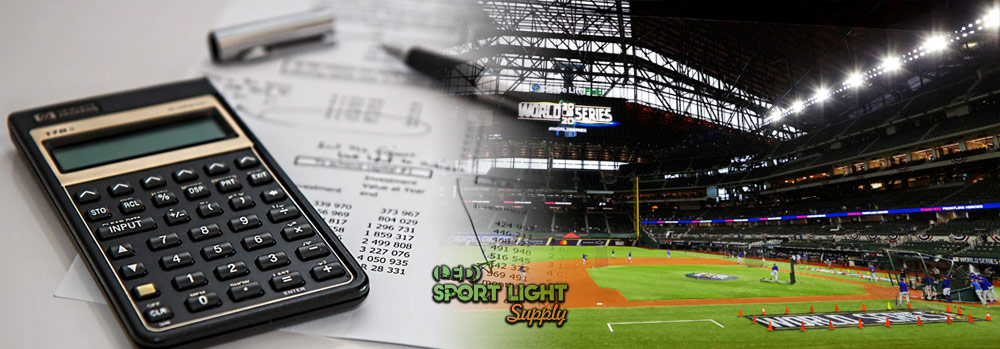
How to Calculate Baseball Field Lighting Cost
The workflow is that we need to calculate the lumen required for the baseball field.
- Lumen required = lux required x baseball field area (in sq. meter) x 1.2 (light loss factor)
Then, we can convert lumen to wattage of the lighting fixture.
- Watt of LED lights = lumen required / 150 (lumens per watt)
Finally, we can get the price of the baseball stadium lights.
- Baseball lighting price = watt of LED lights x ($0.6 to $1.5)
* Assuming baseball field area: 6500 sq. meter
| Type of baseball field | lux required | Baseball field / stadium lighting cost |
| Recreational | 400 lux | $12,480 to $31,200 |
| High school / college | 700 lux | $21,800 to $54,600 |
| Professional | 1500 lux | $46,800 to $117,000 |
a) Lighting Cost of Recreational Baseball Field (400lux)
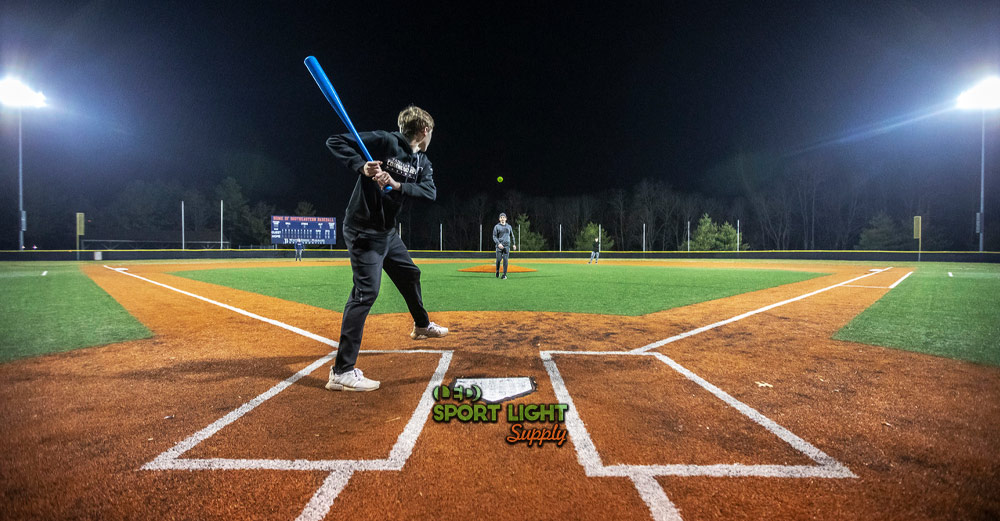
Assuming 400 lux lighting is required for a recreational baseball field.
Formula to calculate the baseball field lighting cost:
- lumen required = 400 lux x 6,500 sq. meter x 1.2 = 3,120,000 lumens
- LED wattage needed = 3,120,000 lumens / 150 lumens per watt = 20,800 watts
- Lamp cost = 20,800 watts x $0.6 to 20,800 watts x $1.5 = $12,480 to $31,200
b) Lighting Cost of High School/College Baseball Field (700lux)
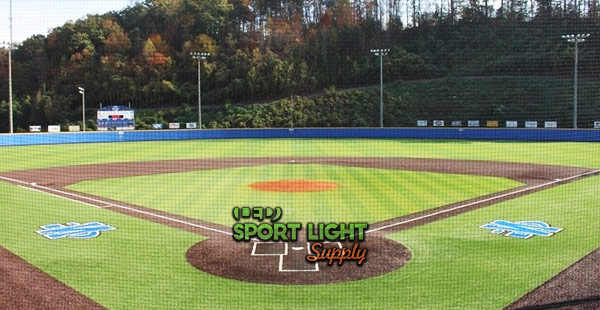
Computation for high school/college baseball field:
- lumen required = 700 lux x 6,500 sq. meter x 1.2 = 5,460,000 lumens
- LED wattage needed = 5,460,000 lumens / 150 lumens per watt = 36,400 watts
- Baseball field lighting cost = 36,400 watts x $0.6 to 36,400 watts x $1.5 = $21,800 to $54,600
c) Light Cost of Professional/MLB Baseball Diamond Stadium
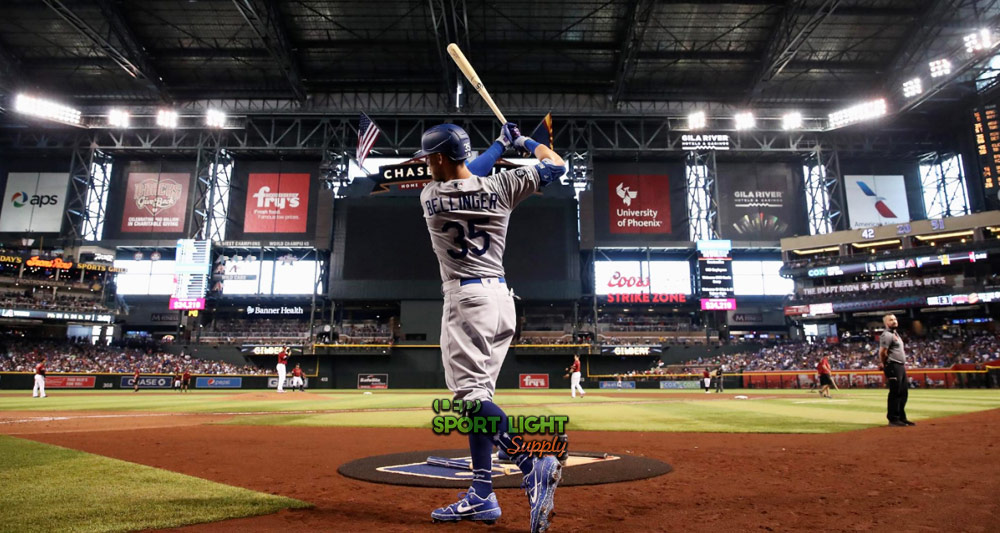
Computation for baseball world cup, MLB (1500 lux):
- lumen required = 1500 lux x 6500 x 1.2 = 11,700,000 lumens
- LED baseball lighting wattage needed = 11,700,000 lumens / 150 lumens per watt = 78,000 watts
- Lighting cost = 78,000 watts x $0.6 to 78,000 watts x $1.5 = $46,800 to $117,000
Baseball/Softball Stadium Lights Running Cost
Before replacing or retrofitting baseball stadium lights, let’s see how much we can save in running costs.
How to Calculate Baseball Field Running Cost
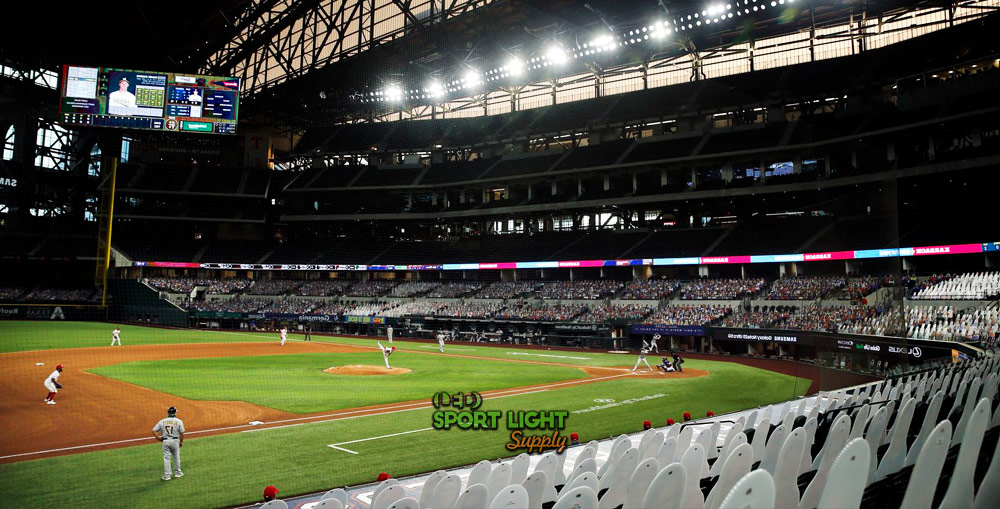
For example, we need 10,000 watts of LED lights, and we need to turn on for 6 hours per day.
- The baseball field lighting running cost = 10,000W x 6 hours x $0.1 / 1000 = $6 per day, $180 per month, $2,160 per year.
If we use halogen lights, we need 100,000 watts halogen to produce equivalent brightness of 10,000 watts LED.
- The baseball field lights running cost = 100,000W x 6 hours x $0.1 / 1000= $60 per day, $1,800 per month, $21,600 per year.
Therefore, we can see that the running cost is 10 times higher if we use halogen lights. This is why it is recommended to use LED lights – 10,000W LED brightness is equivalent to 100,000W halogen lights, and 30,000 to 40,000W metal halide.
Factors Affecting Baseball/Softball Field Lighting Cost
1. Level of Competition
The games are divided into different levels, such as recreational, region competition, national and international baseball tournament. The lighting cost will vary because we have different lighting requirements at different levels. Since we need brighter lights in more professional baseball stadiums, we need higher lumen lights.
| Level of competition | Infield lux requirement | Outfield lux requirement |
| Recreational | 400 lux | 200 lux |
| High school / College / Training | 700 to 1000 lux | 350 to 500 lux |
| Professional (MLB) | 1500 lux | 1000 lux |
The recreational baseball field requires 400 lux for infield and 200 lux for outfield, while the high school or training field needs 700 – 1000 lux for infield and 350 – 500 lux for outfield. As the lux required for high school baseball field is about twice that of a recreational softball field, we can expect that the lighting cost will also double.
2. Baseball Field Size
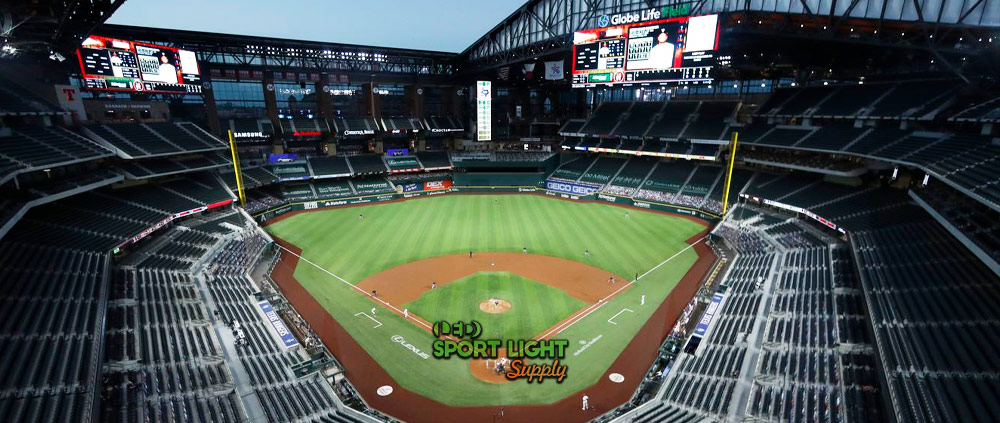
As required lumens = lux level x baseball field size (in sq. meter), the lumen (& wattage) of lighting is directly proportional to the area that needs to be illuminated. The following table summarizes the dimension and area of the common softball fields.
| Baseball field radius | Area |
| 46 m (150 ft) | 6,500 sq. m (70,000 sq. ft) |
| 53 m (175 ft) | 8,820 sq. m (95,000 sq. ft) |
| 61 m (200 ft) | 11,700 sq. m (126,000 sq. ft) |
| 69 m (225 ft) | 15,000 sq. m (161,000 sq. ft) |
| 76 m (250 ft) | 18,100 sq. m (195,000 sq. ft) |
| 84 m (275 ft) | 22,200 sq. m (239,000 sq. ft) |
| 91 m (300 ft) | 26,000 sq. m (280,000 sq. ft) |
3. Light Source
The prices of LED, halogen, metal halide and mercury vapor baseball stadium lights are different. You may find that under the same power consumption, LED is a bit more expensive than the HID lights. However, we can’t just look at the power consumption because these light sources have different luminous efficacy (lumens per watt).
For example, the brightness of a 100W LED lamp is equivalent to 1,000 halogen lamps, because the output power of the LED is up to 150 lumens/watt, while the output power of a halogen bulb is about 15 lumens/watt.
In order to compare the prices of different softball field lights more accurately, we can use the price per 100 lumens. This is because lumens can truly reflect the brightness of the light source. For example, if 150,000 lumens of LED is $8,000, the price is $5.3 per 100 lumens.
4. Height of Light Pole
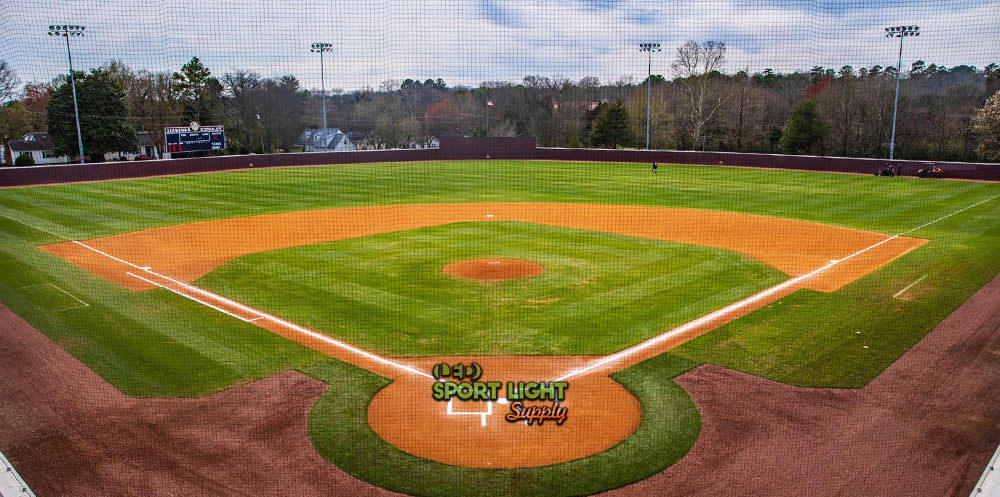 The height of the light pole affects the lighting cost of baseball or softball fields. If the light pole is taller, the light loss will be higher, so we will need more lights to compensate. This is because light will weaken as it travels through the air.
The height of the light pole affects the lighting cost of baseball or softball fields. If the light pole is taller, the light loss will be higher, so we will need more lights to compensate. This is because light will weaken as it travels through the air.
| Type of baseball field | Common light pole height |
| Recreational / Training | 12 to 15 m (39 to 49 ft) |
| High school / college | 15 to 20 m (49 to 65 ft) |
| Professional baseball stadium | 25 to 60 meters (82 to 196 ft) |
In addition, if the pole is very high, we need to spend more money on the lightning protection system.
5. Light Pole Layout
The light pole layout can vary from 4-pole, 6-pole, or 8-pole configuration. Generally, in an 8-pole arrangement, the light cost is lower, because each pole is responsible for a smaller area, so the light loss is smaller. However, the cost of light poles and installation costs are relatively high.
If we want to save the light pole cost and installation time, we can adopt 4-pole or 6-pole layout. However, we will need to use a smaller beam angle floodlight, which in turn increases glare.
6. Solar Panel
Some baseball stadium owners may want to install solar panels to save operating costs. Although solar light cannot completely replace the entire lighting system, we can indeed save 5% to 15% of electricity bills.
Solar cells can be charged in the sun, and we can reuse the energy at night. However, we need to ensure that the roof of the baseball stadium can receive enough sunlight. Otherwise, the battery cannot be charged quickly.
7. Lamp Origin
You will get different quotes if you buy the baseball field lights from various countries or regions. Generally, if you buy from the US, UK, Australia or other Western countries, the price of the lighting fixture may be higher. If you want to save costs, we can try to contact sports lighting suppliers in India or China. You will get cheaper lights for baseball stadiums because of their lower labor costs and overall manufacturing costs.
However, we should avoid lighting that is too low-priced, such as less than $0.3 per watt (for example, less than $300 for a 1000-watt LED). This is because you may buy shoddy products – the lights will not last long.
8. CRI Required
If we need to use very high CRI lighting on a baseball field (for example, >85), more lighting fixtures will be needed because the lumen output is suppressed for high CRI adjustment. CRI requirements for international baseball stadiums are usually 80+ to 90+.
Obtaining higher CRI lighting is necessary because baseball players and spectators can see the vivid colors in baseball diamonds. In addition, bright high CRI lights will make your baseball field look more professional.
9. Lighting Uniformity Required
If the baseball field requires high lighting uniformity, we will need to add additional light, thereby increasing the overall lighting cost. In order to improve lighting uniformity, such as minimum-to-average or minimum-to-maximum illuminance ratio, we will need to add lights in corners or other shaded areas. The idea is that we need more lights to fine-tune the lux level in each sampling area.
The general requirement for infield is about 0.6 to 0.7. If we need 0.8 light uniformity, the price of baseball field lights can be increased by 5% to 10%. If the uniformity of the lighting is too low, the bright and dark spots may easily fatigue the eyes of athletes and spectators.
10. Special Lighting Control System
At the baseball stadium, we are talking about controlling more than 50 to 100 LED flood lights at once. A good lighting control system can save time and effort to turn on and off all baseball field lights.
Smart stadium lighting system is more expensive because it involves advanced DMX or DALI lighting control, computer system and lighting software. You can set a schedule and program the lights so that the lights can be turned on automatically during different baseball games.
How to Reduce the Baseball Field Lighting Cost
Many people may think that the lights used in baseball stadiums are very expensive, and in some cases it is true. Yet, we can still find ways to reduce the lighting cost while meeting the lighting requirement of baseball field. You can save up to 5% to 20% of the lamp price if you following the tips below.
1. Having a Good Baseball Field Lighting Layout
Getting a good lighting design and layout of the baseball stadium can save your cost because we can avoid using too many lights. Indeed, we can always use an unlimited number of floodlights to achieve a certain illuminance and lighting uniformity. The most important point here is to use the least lighting power to meet these lighting requirements.
The purpose of the DIALux photometric study is to find the best lighting arrangement for your baseball fields. By combining different powers and beam angles, we can use a smaller power (and therefore a lower price) to get better results.
2. Using LED Lights
Although the initial cost of LEDs is higher than other traditional HID light sources, LED lights in baseball or softball fields are still worth the investment. Because LEDs are more energy-efficient, we can minimize the power used in baseball fields or baseball fields, thereby saving electricity bills in the long term.
In addition, the lifetime of LEDs is as long as 150,000 hours, so we don’t need to worry about replacement in the next few decades. This is why so many baseball stadium owners have begun to replace or retrofit their metal halide, HPS or mercury vapor baseball lights with LEDs.
3. Ask for Discount for Bulk Order
Just asking for a discount if you buy more than 50+ pcs of LED lights for a baseball stadium. Why not ask the supplier to provide a discount before purchasing the lamps? Bulk ordering will give you more opportunities to get discounts on purchases.
Most sports lighting suppliers will provide you with manufacturer or wholesale prices without request. It is better to negotiate the price so that you can have a good deal. You can even notify the supplier that you will order again in the future. The lighting suppliers are willing to provide additional discounts.
4. Buying used baseball field lights for sale
Another easy way to save money is to buy second-hand (used) baseball field lights on sale. The price of the lights is about 30% to 50% of the original cost, which means you can enjoy up to 70% discount.
Why are there the used lights? When baseball stadium owners replace metal halide or mercury vapor with LED lights, they may wish to sell their used lamps. If your budget is very tight, then buying second-hand baseball lights will be a convenient way to save money.
However, the downside is that second-hand lights may not be suitable for your baseball field. This is because every baseball field has different light pole height and layout. Longevity and warranty are another issue. No one knows how long the baseball stadium lights has been used, so the remaining life span is unknown.
5. Compare the Price of the Baseball Field Lights from Different Countries and Locations
We don’t need to rush to buy baseball field lights within a week (unless you need to complete the lighting installation next month). If we compare the pricing of different companies and countries/regions, we can save extra money and get greater profits. In this way, you can know the average and reasonable price range of baseball stadium lighting. If you want to get high-quality lighting at the best price, we should avoid unusually high and low quotations.
6. Use More Light Poles
Why use more poles can save the lighting cost of the softball field? Since the light poles around the baseball diamond are denser, each light pole is responsible for illuminating a smaller area. Since the light beam travels shorter, light loss can be reduced. For this, we can even adopt an 8-pole design. However, the installation cost of the pole will be higher.
In addition, using more poles can improve the lighting uniformity and reduce glare, because we can use wider beam angle floodlights in baseball stadiums.
7. Use Shorter Poles
Similarly, shorter poles can reduce light loss, so we can reduce the total lumens required. If the light pole is lowered by 3 to 5 meters, we can reduce the lighting cost by 5% to 10%.
However, the drawback of the short light pole is that it will reduce the lighting uniformity, so some shadow areas may be formed in the baseball field. A baseball field light pole height between 20 and 30 meters is reasonable.
How to Select the Best Cheap Baseball or Softball Field Lighting Fixtures
Choosing the best cheap baseball stadium lighting is not as difficult as it seems. Let’s look at the following factors.
1. Luminous Efficacy
Luminous efficiency represents the energy efficiency of the light source. The luminous efficiency of LED is about 130 to 200 lumens per watt, metal halide is 65 to 80 lumens per watt, and halogen is 10 to 20 lumens per watt. If you want to reduce power consumption, you may choose LED baseball park lights.
The question now is whether 200 lm/W is always better than 130 lm/W? Although 200 lm/W is a more energy-efficient option, it is not the best choice for cost-effectiveness considerations. This is because the 200 lm/W LED chip is more expensive than the 130 lm/W chip, so the overall baseball lighting price will be higher. If you are looking for cheap baseball stadium lighting solutions, we can select 130 to 170 lumens per watt LED.
2. Beam Angle
Choosing the right beam angle can save money. If the light pole is high (over 30 meters), a narrow beam angle of 15° or 25° can be used. If the beam is more concentrated, we can reduce the light loss.
For shorter pole, we can use a wider beam angle, such as 45°, 60° or 90°, so that we can use less light to illuminate a wide area.
3. Life Span
When comparing different softball court lighting products, we need to look at their lifespan. The average lifespan of LED lights is 80,000 to 150,000 hours. The lifespan of cheaper LED lighting for baseball stadiums may be 50,000 hours.
It is recommended to choose the LED with the longest service life, because it can save future replacement and maintenance costs.
4. Heat Dissipation
A good heat dissipation system can extend the service life of LED lights. Whether you are using LEDs, metal halide, mercury vapor or HPS lamps, they all generate heat when turned on. Overheating inside the bulb will reduce brightness and life span.
Passive cooling and active cooling are common heat dissipation designs.
- Passive cooling: Use aluminum or other thermally conductive materials to conduct heat away.
- Active cooling: Use a cooling fan to lower the temperature of the lamp. Although it can provide a more effective cooling effect, it consumes more power. Non-waterproof cooling fans will affect the IP rating of the entire lamp as well.
5. Consider Portable Field Lights for Temporary Lighting Solution
If we rarely need lighting in a baseball park, we can consider buying or renting a mobile light tower. This is a temporary lighting solution consisting of floodlight, retractable light pole, generator and movable tower. We can easily move the light tower to illuminate a specific area in the baseball field and put it in the storage room after use.
This will be a cheaper lighting solution for baseball field because we don’t need to build the permanent poles and install the lights. The temporary lighting solution package will provide everything needed to illuminate the baseball park.

